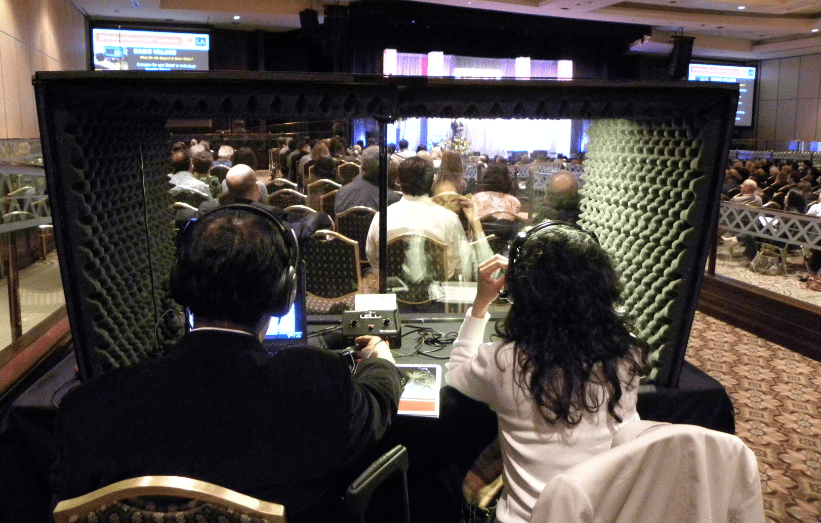The answer is straightforward, no human brain can interpret nonstop for more than 30 minutes without compromising both accuracy and precision.
The rule is simple: Simultaneous interpretation requires a team of two or more interpreters. The most common factor that influences whether a team would be required is the type of interpretation and the length of the event – Now, let us cover all the bases:
What is interpretation, and what do interpreters do?
Interpretation is the process in which the meaning of a language is converted into another language. As you can imagine, conveying a message from one language into another is a demanding process. In fact, it is a difficult task that requires fluency in two languages (including slang and dialect), note-taking skills, and a complete understanding of the culture, customs, and traditions of the people into whose language the speech is interpreted.
An interpreter must first fully understand, analyze, and process the spoken language before rendering it into another language. Imagine how difficult it is to listen to what is being said and simultaneously translate it into another language while trying to comprehend the next sentence. Well, that is what interpreters do. Here at Global YNS, our highly qualified interpreters do it so well that they make it look like a dance! In the proverb “it takes two to tango”, interpreters work together and alternate every 30 minutes to prevent fatigue. This guaranteed solution provides our language interpreters with sufficient time to offer a high-quality and error-free interpretation for you!
Conference Interpreters do an extraordinary, almost impossible job. The world’s most powerful computers cannot perform accurate real-time interpreting of one language to another. Yet human interpreters do it with ease all the time. Conference interpreters perform both onsite remote and remote simultaneous interpretation.
Types of Interpretation: Difference between Consecutive and Simultaneous Interpretation
A message can be delivered from one language into another using the two types of interpretation: with pauses (Consecutive interpretation) or without pauses (Simultaneous interpretation).
Consecutive interpretation is suitable for smaller meetings. The speaker makes a pause every two to three sentences, after which the interpreter delivers what has been said into another language. In the consecutive approach, the interpreter takes notes and can raise their hand to ask for repetitions, clarifications, or even consult a dictionary.
On the other hand, Simultaneous interpretation is suitable for larger meetings such as events, conferences, and webinars. The interpreter, usually speaking into a microphone and wearing headphones, must form a coherent message composed in one language while simultaneously constructing and articulating the same message into another language. While in real-time, the interpreter cannot ask the speaker for pauses or clarifications. Doing so requires versatility and variation beyond the reach of the most powerful machine. But a human brain, indeed, can do it. Simultaneous interpreting is tiring, exhausting, and very demanding. Nowadays, interpreters perform remote simultaneous interpretation using Zoom simultaneous interpretation. Conference interpretation requires simultaneous interpretation equipment.
Now let us go back to our main question: Why do I need two simultaneous interpreters for my event?
As explained above, simultaneous interpretation requires an extraordinary blend of sensory, motor, and cognitive skills, all of which must operate in unison.
Accuracy is the backbone of interpretation, and it’s the first Canon of the interpreters’ “Code of ethics. After 30 minutes of simultaneous interpretation, interpreters need to pause to prevent interpreter fatigue. You need two interpreters simply because they must take turns to recover every half hour.
Additionally, when the speech speed is beyond a certain limit, interpreter’s performance begins to slip, meaning deaf and non-English-speaking audiences receive substandard services. Fast speech is the arch enemy of simultaneous interpreters.
However, the interpreters are always vigilant even when it is their time to recover. While working together, an interpreter is always ready to jump and assist the coworking interpreter. Thus, Interpretation is a collaborative effort.
… But I have seen interpreters working solo for more than two hours. Why should I pay for two interpreters?
Unfortunately, we have seen them too. We have witnessed simultaneous interpreters getting lost in translation and even collapsing from mental fatigue. At Global YNS, we understand the power of words, and we stand by our linguists, interpreter fatigue is real. As the saying goes, “it takes two to tango.” Well, it also takes two to interpret simultaneously.
Interpreter fatigue: Studies have shown that interpreters suffer mental fatigue after about thirty minutes of continuous work—and this fatigue translates (literally) into a loss of accuracy.
Here at Global YNS, we offer superior language services. Our ultimate goal is to build connections through languages and to include more people, families, and communities in more ways. This requires a team of at least two interpreters for Simultaneous interpretation requests.
It is no joke, simultaneous interpretation is tiring, stressful, exhausting, and very demanding. If you care about your audience, and you are serious about language acquisition, you should request at least two conference or simultaneous interpreters for your next event. Getting one interpreter for your event does not mean you are saving money; it means you run the risk of having a low-quality interpretation.
By investing money in your events for more than one interpreter, you have put your heart and soul into the output of your message. You prepare for a successful event by assuring your message does not get lost in translation. If you are working on a tight budget, we will work with you to craft a language solution that works for you without sacrificing quality. Get in touch with us, and together we will explore your options. Remote Simultaneous interpretation is a more affordable option, let’s talk.

Global YNS
Offering superior language solutions,
Where quality is our priority

